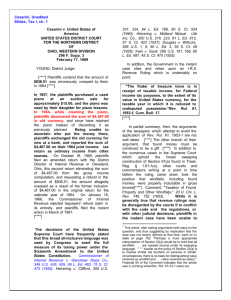Shaeffer_Damages
advertisement
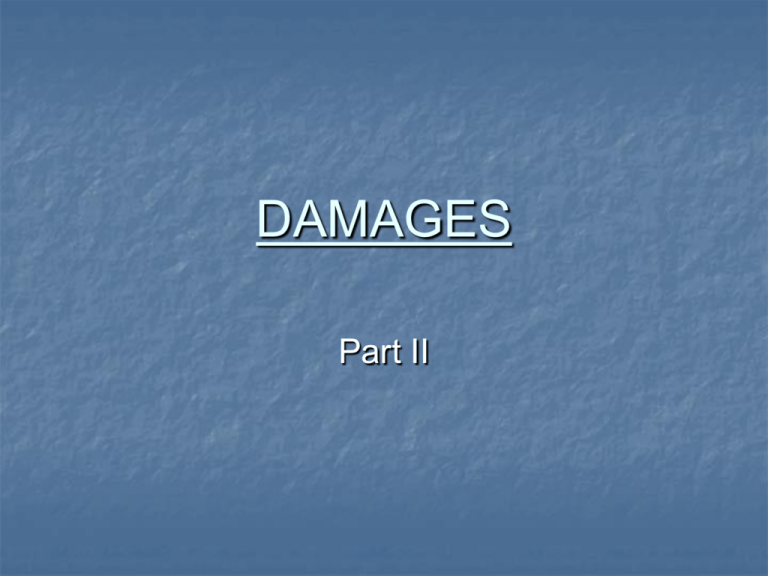
DAMAGES Part II In re Estate of Ferdinand E. Marcos Human Rights Litigation U.S. District Court, Hawaii (1995) Background Marcos was President of Philippines beginning in 1965 Philippines Constitution contained a two-term limit like the U.S. Constitution About a year before he would have to leave office, he suspended the Constitution and declared martial law through Proclamation 1081, with the official purpose stated as: “To maintain law and order throughout the Philippines, prevent or suppress all forms of lawless violence as well as any act of insurrection or rebellion and to enforce obedience to all the laws and decrees, orders and regulations promulgated by [Marcos] personally or upon [his] direction” Background Proclamation 1081 set the stage for the dictatorship that developed thereafter, and resulted in “acts of torture, summary execution, disappearance, arbitrary detention, and numerous other atrocities” Jury found defendants (Marcos’ estate) liable to 10,059 plaintiffs, awarding them $1.2 billion in exemplary damages Compensatory Damages Plaintiffs wanted to use random sample of plaintiffs to represent the damages suffered by the class Defendants claimed this deprived them of due process and the 7th Amendment right to trial by jury Dannemiller’s Plan (Kish Formula) Universe: 9,541 valid claims, separated into 3 categories: 1) torture victims 2) summary execution victims 3) disappearance victims Sample: 137 randomly selected claims Confidence level: 95% Each sample plaintiff would receive the individual amount calculated, while those in the remaining population would each receive the average amount for their category, as calculated from the sample Method Special Master was appointed to: Supervise depositions of sample plaintiffs Serve as expert on damages, reviewing deposition transcripts and claim forms Make recommendations on compensatory damages for the 137 claimants as well as remaining class members to the jury Method Special Master reviewed the depositions for: 1) whether the abuse claimed fell under the definitions which the jury used at the liability phase (torture, summary execution, and disappearance) 2) whether the Philippine military or paramilitary was involved in such abuse 3) whether the abuse occurred between September 1972 and February 1986 Results 137 randomly selected plaintiffs 67 torture victims 52 execution victims 18 disappearance victims Special master recommended an amount of damages for each category, but jury didn’t have to accept it Jury returned verdict for total of over $766 million (about $1 million less than Special Master recommended) Damages for Torture Ranked each claim from 1-5, with 5 being the worse in terms of abuse and suffering Special Master found the claims were similar enough within each of these categories that he could recommend a standard damage amount to each victim within that grouping Evaluations included considerations of: 1) physical torture 2) mental abuse 3) amount of time torture lasted 4) length of detention if applicable 5) physical and/or mental injuries 6) victim’s age 7) actual losses (i.e. medical bills) Damages for Summary Execution and Disappearance Factors in determining damages included: Whether there was any torture first The actual killing or disappearance (wrongful death) Family’s mental anguish Loss of earnings Cap of $120k maximum None for victims who didn’t work When witness didn’t provide an amount, the average for the victim’s occupation was used Due Process Issue Right of defendant to try every single claim versus efficiency and practicality Trying each of the plaintiffs in this case would take decades Due process goes both ways Court concludes that “inferential statistics with random sampling produces an acceptable due process solution to the troublesome area of mass tort litigation” Due Process Issue Court uses the balancing test used in Mathews v. Eldridge to help decide this issue: 1) Private interest affected Liability has already been determined, so it’s really just the amount of damages paid out Each plaintiff still has to prove their claim 2) Risk of erroneous deprivation of that interest through the procedures used Weighs in favor of the statistical method because the verdict would probably have been MORE in a one-on-one trial 3) Government’s interest One-on-one trials would be much more burdensome on the Court in terms of time and cost; maybe some claims would never even get determined Due Process Issue One of the primary purposes of due process is to maximize accuracy Common assumption that awarding nonsample plaintiffs the mean damages award from the sample will under- or overcompensate many people with respect to the “right” amount they would get in an individual trial Due Process Issue What is the “right” damages award? Saks and Blanck suggest the concept of the correct damages amount is an illusion “Every verdict is itself merely a sample from the larger population of potential verdicts” In traditional cases by accepting only one verdict, we’re therefore accepting some likelihood of error So individualized trials substitute one type of error for another By conducting “mini-trials” and awarding the average to the rest of the class by subgroup, we may be ensuring better accuracy than we could by conducting all individual trials Note: the more different the individual cases, the less accuracy benefits This can be countered to some extent by choosing larger samples, or by increasing stratifications Seventh Amendment Issue Seventh Amendment “was designed to preserve the basic institution of jury trial in only its most fundamental elements, not the great mass of procedural forms and details…” Jury determined all the facts during the liability phase; no need to repeat them in the claims phase The rules of evidence and procedure were followed The Tort Victim Protection Act which this case arises under doesn’t discuss the determination of damages, so the court is left with the discretion to create federal common law to deal with the issue In re Chevron U.S.A., Inc. U.S. Court of Appeals, 5th Circuit (1997) Background Chevron used the land in question during the 1920s for a crude oil storage waste pit Plaintiffs allege Chevron didn’t secure the land after they stopped using it, allowing waste to be deposited there Chevron then allegedly sold the land for residential purposes knowing it was contaminated Plaintiffs sued for personal injury and property damages resulting from the hazardous materials “migrating into the environment” Trial Plan “Bellwether” trial 30 plaintiffs 15 chosen by plaintiffs 15 chosen by defendants All adults (unless part of a household represented by an adult) Each chosen individual counts as a single plaintiff Focus on the individual claims of the selected plaintiffs and the issue of liability of defendant for pollutants giving rise to all of the plaintiffs’ claims Bellwether verdicts would be matched to the remaining claims for settlement purposes Weaknesses How does resolving the claims of these 30 plaintiffs resolve the claims of the other 2970? What variables exist that impact the claims? Chevron believed the majority of plaintiffs sustained no injuries and developed no serious health problems Also believed that the class was extremely heterogeneous Contrast to plaintiff’s bellwether selections, which suggested that at least half of all plaintiffs were seriously ill Court decides this is not a legitimate “bellwether trial” because the 30 people chosen are not representative of the 3000 member group of people Misses all but the most extreme cases Dr. Frankiewicz’s Findings This self-selected sample is not representative of population of plaintiffs The average number of medical complaints per plaintiffs chosen by plaintiffs’ counsel is nine, exceeding the average number within the entire plaintiff population by 333% The medical complaints of plaintiffs chosen by plaintiffs’ counsel exaggerate the average severity of the entire class by at least 500% How to Correct the Method To be valid, the sample must be: Randomly selected Of sufficient size To achieve statistical significance To the desired level of confidence Stratified random sample, as used in In re Marcos, would have been preferable Assuming that the universe is sufficiently homogenous to be able to create effective stratifications Holding While this trial plan was invalid, a trial court can potentially use a bellwether trial of legitimately selected, representative plaintiffs and apply those results to the issues relating to the rest of the class of plaintiffs The verdicts for the selected plaintiffs are valid, but under this structure those verdicts can’t be used to make any inferences with respect to the nonselected plaintiffs Holding Before a court can apply results from a bellwether trial to a use outside of those particular cases, it has to find that the bellwether cases are representative of the larger population of cases Such finding must be based on solid statistical evidence identifying the variables involved Must have large enough sample to provide a high enough level of confidence in the accuracy of the results Open Questions (Jones’ Dissent) Even if a proper bellwether trial does increase accuracy, could it still be unconstitutional? What about due process for the nonbellwether plaintiffs? What effects do these nontraditional methods have in the future, when the findings may be reassessed?

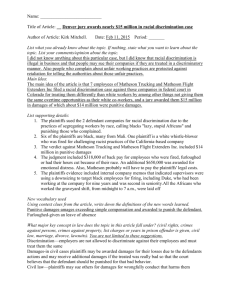
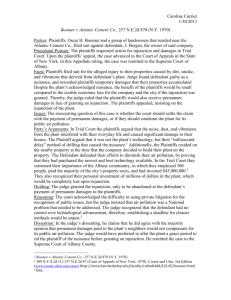
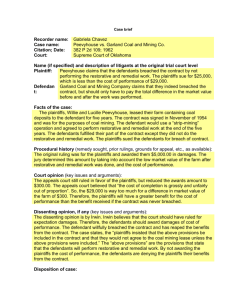

![[Click and Enter Attorney Name], State Bar No - E](http://s3.studylib.net/store/data/007177564_1-4d9407aff5e1ecb2a5922cd955484ee2-300x300.png)
